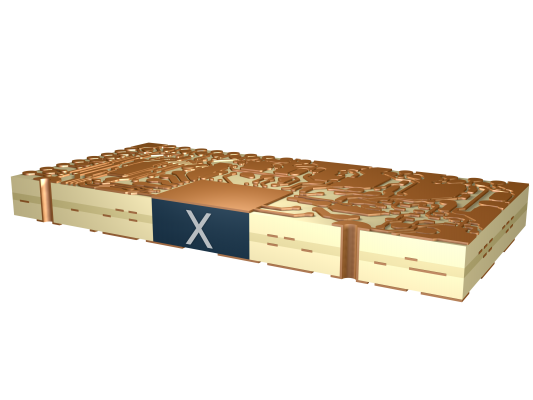Leoben, November 29, 2017 – In addition to its comprehensive portfolio of standard printed circuit board (PCB) technologies, AT&S also has various special processes, materials and technologies that are optimized for specific requirements like high-density wiring, enhanced thermal performance or high frequency (HF). Yet many customers’ designs often only require these high-performance but more expensive technologies in small areas of the PCB. So it makes sense to combine low-cost standard boards with the relevant higher-priced, high-end technologies – but only where they are needed. AT&S meets these requirements with its X-in-Board concept.
X-in-Board enables a combination of different technologies and materials within any common PCB, such as a standard FR4 board or multi-layers with vias (connections between layers) and PTHs (plated through holes). The principle is that the main board is combined with a high-performance inlay, e.g. to optimize heat dissipation, HF characteristics or wiring density.
As a result, in applications such as servers or notebooks, elements with high-density wiring (multi-layer inlays) can be partially integrated directly into the overall structure, so the customer can reduce the overall PCB thickness. In times of high cost pressure, with PCBs becoming ever thinner, this is an important criterion. For HF applications such as radar systems in automobiles, special HF inlays can be integrated (e.g. based on ceramic materials such as those by Rogers).
Another field of application for X-in-Board technology is heat management. Particularly in the automotive sector, there are applications for high-power LEDs. These place greater thermal demands on the PCBs. The PCBs that are currently used, with conventional via and PTH structures, may not be able to adequately dissipate this heat, which can cause LEDs to malfunction. Using metal core PCBs based on IMS (insulated metal substrate) or solid copper (Cu) components as an inlay allows optimal thermal transfer through the PCB, and means that power electronics and control electronics can be combined. The power electronics can be LED applications, or alternatively conventional power electronics such as MOSFETs.
For the various application examples mentioned, AT&S has developed and produced prototypes or customer samples. Partial integration of copper inlays into the PCB is already in mass production.























